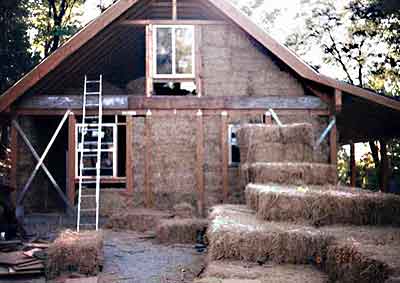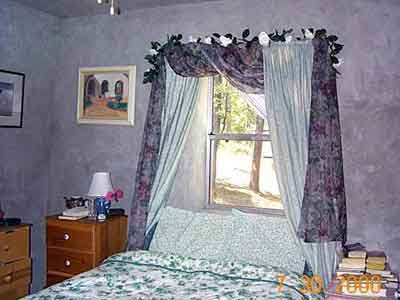The following article was generously submitted by Michelle Mahood, professional photographer and animal-lover in Redding, California.
*Building a Straw House: /Just do it!/
Our straw bale house was a several year long project for my daughter and I. While I worked on it, I lived in a little single-wide trailer on my property. I helped as much as possible with whatever I could, and hired low cost or even out-of-work subcontractors for various parts of the project. The plaster guys worked for a reduced rate when their other jobs were rained out. Black oak was exchanged for rough plumbing. Two weekend wall-raisings were held and people showed up from all over to help!
 The
house is post-and-beam -- only because studies proving the strength of
load bearing walls had not yet been done at the time. Of the $25,000 building
cost, $8,000 was lumber. There are a lot of 6x6's! Do-it-yourself'ers
now have the option to omit much of the expensive lumber using a "Nebraska
style" design rather than post-and-beam.
The
house is post-and-beam -- only because studies proving the strength of
load bearing walls had not yet been done at the time. Of the $25,000 building
cost, $8,000 was lumber. There are a lot of 6x6's! Do-it-yourself'ers
now have the option to omit much of the expensive lumber using a "Nebraska
style" design rather than post-and-beam.
My county had no provisions for such a house at the time but was quite flexible about it. They simply checked off the permit, marking "experimental" where they had no relevant Code sections to adhere to. I was required to have my plans approved first by an engineer, which was easy.
Misconceptions about straw bale are common. Here's a few I hear: "Aren't
you afraid your house will catch fire?" Actually, no. It's almost impossible
to burn a straw house because tightly packed bales allow very little air
space. My house will smolder for hours but won't actually burn, whereas
a stick-frame wall lasts about 10 minutes. Another popular one is "Aren't
you afraid of rodents or animals wanting to eat your house?" Actually,
no. Straw is a waste product. Nothing wants to eat it. Even if something
did want to, the walls are coated with plaster both inside and out. That's
fiber-reinforced concrete -- not decorative stucco. So far, nothing appears
to be chiseling through in an effort to eat my house. 
About the other misconception -- The Big Bad Wolf... Luckily, we haven't seen him!
Construction photos of my straw bale house. First of its kind in Northern California. With the help of lots of friends and a lot of elbow grease, it got built for about $25,000. The R-value in the walls approaches R-55. It's quiet, cozy, and not like anyone else's house.